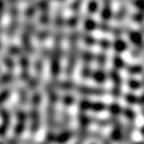
NaWO3Tungsten-bronze
with Tetragonal Lattice
The First Non-Cuprate
High-temperature Superconductor
Courtesy: Iowa State High-Tc
August 1, 1999
With UPDATE October, 2000
HIGH-Tc UPDATE E-MAIL VERSION, VOL. 13, NO. 15
Aug. 1, 1999
NOTA BENE:
Na0.05WO3 Surface-Doped Tungsten-Bronze
A recent preprint by S. Reich and Y. Tsabba (Weizmann Institute) reported experimental evidence suggesting the possibility of superconductivity with Tc ~ 91 K in WO3 crystals with a surface composition of Na0.05WO3. (For further details, see Nota Bene and the preprint listing in the May 1 issue of High-Tc Update.) A. Shengelaya and K. A. Mueller (Zurich) now have joined with Reich and Tsabba to carry out electron-spin-resonance (ESR) measurements on samples of WO3 doped with Na. According to a new preprint, the authors detected an ESR signal with unresolved fine and/or hyperfine structure, and they used the saturation method to determine the spin-lattice relaxation rate 1/T_1 of these paramagnetic centers. Upon cooling below about 100 K, 1/T_1 decreased markedly with decreasing temperature. Except for the absence of a Hebel-Slichter peak, the results resemble NMR 1/T_1 measurements when a gap opens in the superconducting state. Below about T = 0.6 Tc, where Tc is assumed to be 91 K, the authors found that1/T_1 proportional to exp(-Delta/k_BTc) with a gap parameter Delta = 160 K or 2Delta/k_BTc = 3.5, in good agreement with the weak-coupling BCS theory. The authors emphasize that for YBa2Cu3O7-d compounds, no ESR such as that reported here is known, thus excluding possible contamination of the WO3:Na samples by YBCO as the origin of the superconducting signatures with a Tc of 91 K.
The authors also report temperature-dependent field-cooled (FC) and zero-field-cooled (ZFC) dc susceptibility data obtained with a SQUID magnetometer. The two curves differ strongly below Tc, with the FC magnetization lying above the ZFC magnetization. In contrast to the cuprate superconductors, the parent compound WO3 is nonmagnetic, indicating that when WO3 is doped with Na, antiferromagnetism could not be responsible for either the magnetization hysteresis or the high Tc. The authors interpret all their results as suggesting a 91 K transition from a semiconducting to a nonpercolating 2D superconducting state on the surface of an insulator (a bulk WO3 crystal) when the surface is doped with sodium.
As of October, 2000, Shimon Reich reports that the 91K Tc has been confirmed, but
is localized in small islands about 100nm across and 10nm in height on the surface of the
material. He also states that, as yet, no other tungsten-bronze compounds have exhibited this kind of high-temperature
2D superconductivity. Rb and Cs surface-doped WO3 only exhibit Tc's ~6K.
Dr. Reich is currently collaborating with Dr. Millo of the Racah Institute
in Jerusalem to continue this research.
NOTE: For a definition of a "tungsten-bronze", visit the Terminology
page. Or for a few more examples of TB's, go to the bottom of the Type 2
page.

 BACK to the "History" page at Superconductors.ORG
BACK to the "History" page at Superconductors.ORG
 BACK to the "Atypical" page at Superconductors.ORG
BACK to the "Atypical" page at Superconductors.ORG
 BACK to the "Terminology" page at Superconductors.ORG
BACK to the "Terminology" page at Superconductors.ORG
 BACK to the "News" page at Superconductors.ORG
BACK to the "News" page at Superconductors.ORG



![]()
 BACK to the "History" page at Superconductors.ORG
BACK to the "History" page at Superconductors.ORG
 BACK to the "Atypical" page at Superconductors.ORG
BACK to the "Atypical" page at Superconductors.ORG
 BACK to the "Terminology" page at Superconductors.ORG
BACK to the "Terminology" page at Superconductors.ORG
 BACK to the "News" page at Superconductors.ORG
BACK to the "News" page at Superconductors.ORG